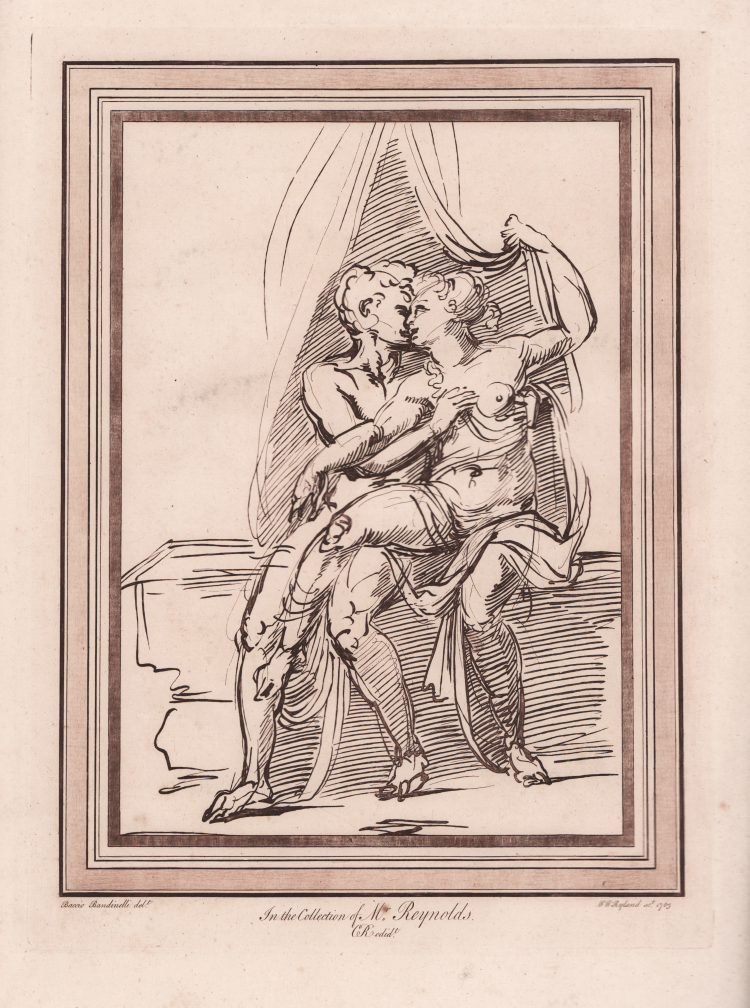



| Reference: | S1591 |
| Author | William Wynne Ryland |
| Year: | 1763 |
| Measures: | 260 x 345 mm |


| Reference: | S1591 |
| Author | William Wynne Ryland |
| Year: | 1763 |
| Measures: | 260 x 345 mm |
Etching printed in brown ink, lettered below the image "In the Collection of Mr. Reynolds. CR edidt. Baccio Bandinelli delt. W.W. Ryland sct. 1763".
After a drawing by Baccio Bandinelli.
A fine impression, printed on contemporary laid paper, with margins, perfect condition.
The work is part of Charles Rogers, A Collection of Prints in Imitation of Drawings. To which are annexed lives of their authors. printed by J. Nichols in London, and sold by John Boydell, Benjamin White, and Peter Molini, 1778.
The plates, which use a wide variety of techniques, show some old master drawings in Rogers's own collection. His preface states: “That these prints may be faithful imitations, they are engraved the same way as, as well as the same size, as the Originals are drawn; and printed, as nearly as possible, in the same colours”.
A fine impression, printed on contemporary laid paper, with margins, perfect condition.
|
R. Weigel, Die Werke der Maler in ihren Handzeichnungen p. 77 no. 122.
|
William Wynne Ryland (Londra 1732 - 1783)
|
William Wynne Ryland was an English engraver, who pioneered stipple engraving and was executed for forgery. Ryland was born in London, the eldest of seven sons of Edward Ryland (died 1771), an engraver and copper-plate printer. He studied engraving under Ravenet in London, and, in Paris, drawing under François Boucher and engraving under Jacques-Philippe Le Bas. After spending five years on the continent he returned to England, and having engraved portraits of George III and Lord Bute (after Ramsay), and a portrait of Queen Charlotte and the Princess Royal after Francis Cotes, R.A., he was appointed engraver to the king - a position that carried a salary of £200 per annum.
In 1766 he became a member of the Incorporated Society of Artists, and he exhibited with them and in the Royal Academy. In his later life Ryland abandoned line engraving, and introduced chalk-engraving, in which the line is composed of stippled dots, and in which he transcribed Mortimer's "King John Signing Magna Carta", and copied the drawings of the Old Masters and the works of Angelica Kauffman.
Ryland became prosperous, and seeking an investment, went into partnership with a pupil, Henry Bryer, putting his money into a print shop in Cornhill, London; the business went bankrupt in December 1771. After an interval, he resumed business as a print-seller in the Strand, but before long retired to a private residence at Knightsbridge.
|
|
R. Weigel, Die Werke der Maler in ihren Handzeichnungen p. 77 no. 122.
|
William Wynne Ryland (Londra 1732 - 1783)
|
William Wynne Ryland was an English engraver, who pioneered stipple engraving and was executed for forgery. Ryland was born in London, the eldest of seven sons of Edward Ryland (died 1771), an engraver and copper-plate printer. He studied engraving under Ravenet in London, and, in Paris, drawing under François Boucher and engraving under Jacques-Philippe Le Bas. After spending five years on the continent he returned to England, and having engraved portraits of George III and Lord Bute (after Ramsay), and a portrait of Queen Charlotte and the Princess Royal after Francis Cotes, R.A., he was appointed engraver to the king - a position that carried a salary of £200 per annum.
In 1766 he became a member of the Incorporated Society of Artists, and he exhibited with them and in the Royal Academy. In his later life Ryland abandoned line engraving, and introduced chalk-engraving, in which the line is composed of stippled dots, and in which he transcribed Mortimer's "King John Signing Magna Carta", and copied the drawings of the Old Masters and the works of Angelica Kauffman.
Ryland became prosperous, and seeking an investment, went into partnership with a pupil, Henry Bryer, putting his money into a print shop in Cornhill, London; the business went bankrupt in December 1771. After an interval, he resumed business as a print-seller in the Strand, but before long retired to a private residence at Knightsbridge.
|